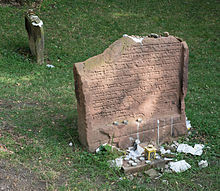Jacob ben Moses HaLevi Molin
Rabbi Yaakov haLevi Moelin , also Jacob ben Moses Mölin haLevi , (יעקב בן משה מולין; born probably 1375 in Mainz ; died on September 14, 1427 in Worms ) was a Talmudist and Posek ( halachic authority). He is known for the codification of the ritual customs of the Ashkenazim , which he summarized in the Sefer Minhagim . The Hebrew acronym of his name MaHaRIL - "Our Teacher, Rabbi Yaakov (Ha) Levi" - is widely known, other alternative names are Mahari Segal or Mahari Moelin . Maharils Minhagim were a source of law for HaMapah , Moses Isserles ' part of Shulchan Aruch . Maharil is considered to be one of the outstanding Jewish scholars at the end of the Middle Ages. The works ascribed to him are reprinted and consulted to this day.
Life
Maharil was the son of Rabbi Mosche Levi Moelin and a student of Rabbi Shalom from Wiener Neustadt . Despite his youth, he earned his reputation through Talmudic studies and piety. He was Rosh the Mainz yeshiva , where his most famous student was Jakob Weil (Mahariv). Maharil survived the time of the Hussite persecution , which also affected the Jews on the Rhine (see: here ). Maharil played an important role in rebuilding Jewish life on the Rhine. His grave is in the Rabbinental des Heiligen Sand in Worms.
plant
Maharil's most famous work, the Sefer Minhagim (Book of Customs), is also known as Minhagei Maharil or Sefer ha-MaHaRIL . It contains a detailed description of Jewish ways of life and rites from the religious as well as the domestic environment and provides a binding demarcation of Ashkenazi customs, with which it has contributed to preserving the unity of Judaism across cultural boundaries. It also contains legal decisions, sermons and text comments. He laid down the order of worship for the German parishes, promoted Torah studies and determined: Mainz must remain Mainz. The liturgical chants of the Holy Congregation Magenza cannot be changed.
In 1556 it was first published with numerous additions in Sabbioneta by Maharil's student Zalman von Sankt Goar . It influenced the religious, cultural and social history of the Ashkenazi Jews significantly. Moshe Isserles quotes Maharil regularly in the Shulchan Aruch , the summary of religious regulations that has been revised by several generations of rabbis.
In Maharil's work, the special connection to his hometown Magenza, the Jewish Mainz, is expressed, as he repeatedly writes about "our city" and refers to people and customs in Mainz at the end of the Middle Ages .
Maharil is partially identified with the writer of a 14th century manuscript known as Abraham von Worms .
Works
- Yitzhak sentence: New Responsa of Rabbi Yaacov Molin - Maharil (Heb.). Mifʿāl Tôrat Haḵmê Aškĕnaz, Jerusalem 1977 (reprinted 1990/91)
- Yitzhak sentence: Responsa of Rabbi Yaacov Molin - Maharil. Revised and Corrected with Additions according to Previous Editons and Various Manuscripts with Introduction, References Notes, and Commentaries (hebr.). Mifʿāl Tôrat Haḵmê Aškĕnaz, Jerusalem 1979 (reprinted 1990/91)
literature
- Zacharias Frankel : Biographical Sketches XVIII. Jacob ben Mose ha-Levi. In: Der Orient 9 (1848), Sp. 395–400 ( digitized version )
- Leopold Rothschild: The Jewish communities of Mainz, Speyer and Worms from 1349-1438. A contribution to the history of the Middle Ages (diss. Phil. Marburg). Nathansen & Lamm, Berlin 1904, pp. 40–42 ( digitized version of the Freimann collection in the University Library in Frankfurt am Main)
- Sidney Steiman: Custom and survival. A Study of the Life and Work of Rabbi Jacob Molin (Moelln) known as the Maharil (c. 1360-1427), and His Influence in Establishing the Ashkenazic Minhag . Bloch, New York 1963
- Franz Menges: Möllin, Jakob ben Moses ha-Levi. In: New German Biography (NDB). Volume 17, Duncker & Humblot, Berlin 1994, ISBN 3-428-00198-2 , pp. 655 f. ( Digitized version ).
| personal data | |
|---|---|
| SURNAME | Molin, Jakob ben Moses HaLevi |
| ALTERNATIVE NAMES | Molin, Yaakov haLevi; MaHaRIL; Mahari Segal; Mahari Moelin; Möllin, Jakob ben Moses ha-Levi |
| BRIEF DESCRIPTION | Talmudist and Posek (Halachic Authority) |
| DATE OF BIRTH | around 1375 |
| PLACE OF BIRTH | Mainz |
| DATE OF DEATH | September 14, 1427 |
| Place of death | Worms |
